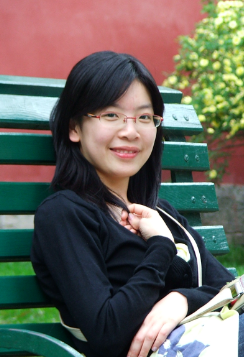Zhaojun Nie 聂肇君

Graduate student, PhD Candidate. Biomedical Engineering, McMaster University
M.Sc Optoelectronic Engineering, Beijing Institute of Technology
B.S Optical Information Science & Technology, Xi'an Institute of Post and Telecomunication.
Contact Information
Office: ITB 112
Email: niez2@mcmaster.ca
Lab : (1)905-963-3777
===Mailing Address===
ETB 405 School of Biomedical Engineering
McMaster University
1280 Main Street West
Hamilton, ON L8S 4L7, Canada
Research
My research is interested in optical biopsy methods including time resolved fluorescence and diffused reflectance spectroscopy for tumor margin observation during interoperation.Clinial instruments has been developed for ex vivo and in vivo clinical study. Upper GI and Brain ex-vivo study have been done by using TRF and TRF/DRS respectivly. The detail of my project are listed as following:
- Integrated system of time-resolved fluoresecence spectroscopy and diffuse reflectance spectroscopy for optical biopsy
Abstract:
Time resolved fluorescence (TRF) spectroscopy and diffuse reflectance (DR) spectroscopy have been used as minimally-invasive optical biopsy modalities. They offer real-time alternatives to invasive tissue biopsies. Fluorescence lifetime is independent of intensity variations and adds an additional source of contrast compared to steady state fluorescence. Diffuse reflectance allows for quantitative measurement of optical properties of tissue. Combining both DR and TRF modalities in one optical biopsy instrument allows for the integration of diffuse reflectance, time-resolved, and steady-state spectra for tissue diagnosis as well as real-time correction of the fluorescence lifetime and spectrum based on optical property measurements in-situ. We have designed and developed an integrated clinically compatible apparatus which acquires time-resolved fluorescence and diffuse reflectance simultaneously. We have also designed and fabricated a dual modality, compact fiber-optic probe for fluorescence and diffuse reflectance signal collection. The performance of the system was evaluated and calibrated using a fluorescence tissue phantom model.
Link for detail:
- Scanning time resolved fluorescence imaging system
Abstract:
we report a fiber-probe based scanning hyperspectral TRF imaging system to capture the FLIM images over a broadband wavelength using the acoustic- optical tunable filter (AOTF). In the meantime, Spectral and lifetime of each scanning pixels are captured as well as morphological information of tissue, which are able to provide much more detail information for tissue diagnosis and margin measurement. Comparing with traditional spectrometer setup, AOTF based spectrometer allowed switching the output wavelength very quickly to realize near real time data collection. The detail of system design and calibration will be given in this paper. Furthermore, tissue phantom and biological tissue study have also been involved to evaluate the system performance.
Link for detail:
- Time-resolved fluorescence and diffuse reflectance spectroscopy study in ex-vivo brain tissue
Abstract:
The ex vivo brain clinical study has been done by using the time resolved fluorescence spectroscopy and diffuse reflectance spectroscopy system respectively to investigate optical properties of brain tumor with normal tissue.14 patients were involved in this study.7 patients diagnosed with glioma were recruited for the study. The patients were scheduled for surgical removal of brain tumor and underwent the planned operation.
Link for detail:
- Time-Resolved Fluorescence Based Optical Biopsy in the UGI Tract: A Pilot ex vivo Study
Abstract:
Screening and surveillance for gastrointestinal (GI) cancers by endoscopic biopsy is invasive, costly, and has the potential for sampling error. Cancer surveillance, as in Barrett’s esophagus, is particularly challenging because of the surface areas of disease involvement.
Endogenous fluorescence of mucosal tissueprovides intrinsic biochemical and physiological information that may enable real-time, functional diagnosis when combined with white-light endoscopy. Time-resolved fluorescence (TRF) spectroscopy characterizestissue fluorescence emission in terms of intensity, spectral distribution, and radioactive lifetime (Figures 1). Therefore, TRF techniques are attractiveforin vivo minimally-invasive optical biopsy applications, which may provide a more efficient approach to improve the sensitivity of(needle)biopsy while reducing the number of biopsies required, increasing surveillance intervals, and reducing cost.
Link for detail:
- Fluorescence lifetime fitting method
Abstract:
(software package is available)link for software
Journal Paper
- Shu-Chi Allison Yeh, Kevin Diamond, Michael Patterson, Zhaojun Nie, Joseph Hayward, Qiyin Fang, “Monitoring Photosensitizer Uptake Using Two Photon Fluorescence Lifetime Imaging Microscopy,” Theranostics; 2(9):817-826, 2012
Conference Poster
- Zhaojun Nie, Derek Capon, Joseph E. Hayward, Thomas Farrell, and Qiyin Fang.”Time-Resolved Fluorescence based optical biopsy technology development”. in Thinking Ahead For a Strong Future Canada Research Chairs 2010.
- F. Tse, L. Liu, D. Armstrong, Z. Nie, M. LePalud, T. Mursalin, M. J. Deen, Q. Fang.”Time-Resolved Fluorescence Based Optical Biopsy in the UGI Tract: A Pilot ex vivo Study” 2011.
- Derek J. Cappon, Zhaojun Nie, Thomas J. Farrell, Qiyin Fang, and Joseph E. Hayward,”A Novel Optical Property Recovery Algorithm for Use in the Optical Biopsy of Brain Tissue” in Digital Holography and Three-Dimensional Imaging, OSA Technical Digest (Optical Society of America, 2012)
Conference Presentation
- M. LePalud, F. Tse, J. Jo, M. Krishnamoorthy, R. Leung, D. Cappon, Z. Nie and Q. Fang, “Time-Resolved Fluorescence Spectra of Upper GI Tract: An Ex-Vivo Study”,217th ECS Meeting: The Hyatt Regency Vancouver and The Fairmont Hotel Vancouver, Vancouver, Canada, April 25-30, 2010
- Zhaojun Nie, Derek Cappon, Joseph E. Hayward, Thomas J. Farrell, Michael S. Patterson, John Provias, Naresh Murty, William McMillan, and Qiyin Fang.”Integrated Time-resolved Fluorescence and Diffuse Reflectance Spectroscopy Optical Biopsy Instrument” in BIOS,2011 SPIE photonics west
- Zhaojun Nie, Derek Cappon, Joseph E. Hayward, Thomas J. Farrell, Michael S. Patterson, John Provias, Naresh Murty, William McMillan, Brian Pikul, William H. Yong ,and Qiyin Fang.”Integrated Time-resolved Fluorescence and Diffuse Reflectance Spectroscopy Optical Biopsy Instrument” in 9th Annual World Congress of SBMT on Brain, Spinal Cord Mapping and Image Guided Therapy,2012
Safety Training
| Base Courses | Additional Courses | |||
|---|---|---|---|---|
| Course | Date | Course | Date | |
| Fire Safety | 2009 | Laser Safety | Sep. 2009 | |
| Office WHMIS | 2009 | Biosafety | Nov.2009 | |
| Asbestos Awareness | 2009 | WHMIS Core | Aug 2010 | |
| Ergonomics | 2009 | |||
| Slips/Trips/Falls | 2009 | |||